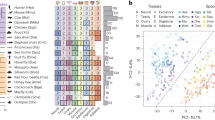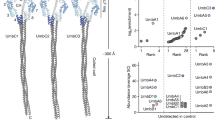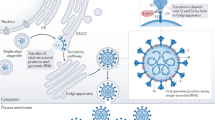Abstract
Microbial pathogens use environmental cues to trigger the developmental events needed to infect mammalian hosts or transmit to disease vectors. The parasites causing African sleeping sickness respond to citrate or cis-aconitate (CCA) to initiate life-cycle development when transmitted to their tsetse fly vector. This requires hypersensitization of the parasites to CCA by exposure to low temperature, conditions encountered after tsetse fly feeding at dusk or dawn. Here we identify a carboxylate-transporter family, PAD (proteins associated with differentiation), required for perception of this differentiation signal. Consistent with predictions for the response of trypanosomes to CCA, PAD proteins are expressed on the surface of the transmission-competent ‘stumpy-form’ parasites in the bloodstream, and at least one member is thermoregulated, showing elevated expression and surface access at low temperature. Moreover, RNA-interference-mediated ablation of PAD expression diminishes CCA-induced differentiation and eliminates CCA hypersensitivity under cold-shock conditions. As well as being molecular transducers of the differentiation signal in these parasites, PAD proteins provide the first example of a surface marker able to discriminate the transmission stage of trypanosomes in their mammalian host.
This is a preview of subscription content, access via your institution
Access options
Subscribe to this journal
Receive 51 print issues and online access
$199.00 per year
only $3.90 per issue
Buy this article
- Purchase on Springer Link
- Instant access to full article PDF
Prices may be subject to local taxes which are calculated during checkout




Similar content being viewed by others
References
Fang, J. & McCutchan, T. F. Thermoregulation in a parasite’s life cycle. Nature 418, 742 (2002)
Engstler, M. & Boshart, M. Cold shock and regulation of surface protein trafficking convey sensitization to inducers of stage differentiation in Trypanosoma brucei . Genes Dev. 18, 2798–2811 (2004)
Lee, S. H., Stephens, J. L., Paul, K. S. & Englund, P. T. Fatty acid synthesis by elongases in trypanosomes. Cell 126, 691–699 (2006)
Hao, Z. et al. Tsetse immune responses and trypanosome transmission: implications for the development of tsetse-based strategies to reduce trypanosomiasis. Proc. Natl Acad. Sci. USA 98, 12648–12653 (2001)
Zilberstein, D. & Shapira, M. The role of pH and temperature in the development of Leishmania parasites. Annu. Rev. Microbiol. 48, 449–470 (1994)
Billker, O. et al. Identification of xanthurenic acid as the putative inducer of malaria development in the mosquito. Nature 392, 289–292 (1998)
Barrett, M. P. et al. The trypanosomiases. Lancet 362, 1469–1480 (2003)
Fenn, K. & Matthews, K. R. The cell biology of Trypanosoma brucei differentiation. Curr. Opin. Microbiol. 10, 539–546 (2007)
Szoor, B. et al. Protein tyrosine phosphatase TbPTP1: a molecular switch controlling life cycle differentiation in trypanosomes. J. Cell Biol. 175, 293–303 (2006)
Tasker, M. et al. A novel selection regime for differentiation defects demonstrates an essential role for the stumpy form in the life cycle of the African trypanosome. Mol. Biol. Cell 11, 1905–1917 (2000)
Vassella, E., Reuner, B., Yutzy, B. & Boshart, M. Differentiation of African trypanosomes is controlled by a density sensing mechanism which signals cell cycle arrest via the cAMP pathway. J. Cell Sci. 110, 2661–2671 (1997)
Bruce, D. et al. The morphology of the trypanosome causing disease in man in Nyasaland. Proc. R. Soc. Lond. B 85, 423–433 (1912)
Turner, C. M., Barry, J. D. & Vickerman, K. Loss of variable antigen during transformation of Trypanosoma brucei rhodesiense from bloodstream to procyclic forms in the tsetse fly. Parasitol. Res. 74, 507–511 (1988)
Czichos, J., Nonnengaesser, C. & Overath, P. Trypanosoma brucei: cis-aconitate and temperature reduction as triggers of synchronous transformation of bloodstream to procyclic trypomastigotes in vitro . Exp. Parasitol. 62, 283–291 (1986)
Hunt, M., Brun, R. & Kohler, P. Studies on compounds promoting the in vitro transformation of Trypanosoma brucei from bloodstream to procyclic forms. Parasitol. Res. 80, 600–606 (1994)
Jacobs, S. L. & Lee, N. D. Determination of citric acid in serum and urine using Br82. J. Nucl. Med. 5, 297–301 (1964)
Sherwin, T. & Gull, K. The cell division cycle of Trypanosoma brucei brucei: timing of event markers and cytoskeletal modulations. Phil. Trans. Roy. Soc. Lond. 323, 573–588 (1989)
Shapiro, S. Z., Naessen, J., Liesegang, B., Moloo, S. K. & Magondu, J. Analysis by flow cytometry of DNA synthesis during the life cycle of African trypanosomes. Acta Trop. 41, 313–323 (1984)
Matthews, K. R. & Gull, K. Evidence for an interplay between cell cycle progression and the initiation of differentiation between life cycle forms of African trypanosomes. J. Cell Biol. 125, 1147–1156 (1994)
Kamsteeg, E. J. et al. MAL decreases the internalization of the aquaporin-2 water channel. Proc. Natl Acad. Sci. USA 104, 16696–16701 (2007)
Kirk, P. et al. CD147 is tightly associated with lactate transporters MCT1 and MCT4 and facilitates their cell surface expression. EMBO J. 19, 3896–3904 (2000)
Sbicego, S. et al. The use of transgenic Trypanosoma brucei to identify compounds inducing the differentiation of bloodstream forms to procyclic forms. Mol. Biochem. Parasitol. 104, 311–322 (1999)
Robertson, M. Notes on the polymorphism of Trypanosoma gambiense in the blood and its relation to the exogenous cycle in Glossina palpalis . Proc. R. Soc. Lond. B 85, 241–248 (1912)
Bass, K. E. & Wang, C. C. The in vitro differentiation of pleomorphic Trypanosoma brucei from bloodstream into procyclic form requires neither intermediary nor short-stumpy stage. Mol. Biochem. Parasitol. 44, 261–270 (1991)
Lythgoe, K. A., Morrison, L. J., Read, A. F. & Barry, J. D. Parasite-intrinsic factors can explain ordered progression of trypanosome antigenic variation. Proc. Natl Acad. Sci. USA 104, 8095–8100 (2007)
Tusnady, G. E. & Simon, I. The HMMTOP transmembrane topology prediction server. Bioinformatics 17, 849–850 (2001)
Spyropoulos, I. C., Liakopoulos, T. D., Bagos, P. G. & Hamodrakas, S. J. TMRPres2D: high quality visual representation of transmembrane protein models. Bioinformatics 20, 3258–3260 (2004)
Pusnik, M. et al. Pentatricopeptide repeat proteins in Trypanosoma brucei function in mitochondrial ribosomes. Mol. Cell. Biol. 27, 6876–6888 (2007)
McCulloch, R. et al. Transformation of monomorphic and pleomorphic Trypanosoma brucei . Methods Mol. Biol. 262, 53–86 (2004)
Lanham, S. M. Separation of trypanosomes from the blood of infected rats and mice by anion-exchangers. Nature 218, 1273–1274 (1968)
Field, M. C. et al. New approaches to the microscopic imaging of Trypanosoma brucei . Microsc. Microanal. 10, 621–636 (2004)
Saliba, K. J. et al. Sodium-dependent uptake of inorganic phosphate by the intracellular malaria parasite. Nature 443, 582–585 (2006)
Acknowledgements
We thank E. Ullu for the gift of genomic macroarrays, M. Engstler and M. Boshart for the gift of the AnTat1.1 90:13 line, and A. Schneider for pALC14. We thank D. Hall, P. Davies and D. Levin for technical assistance, P. MacGregor for statistical analysis and A. Paterou and D. Murray for Image analysis. This work was supported by a Wellcome Trust project grant and programme grant to K.R.M. S.D. was supported by a BBSRC studentship, a Wellcome Trust Programme Grant to K.R.M. and by a Journal of Cell Science Travelling fellowship for a visit to the laboratory of K.K. Support was also provided through a Wellcome Trust strategic award for the Centre for Immunity, Infection and Evolution and a BBSRC REI award for confocal facilities.
Author Contributions S.D. carried out all trypanosome experiments, R.M. carried out the Xenopus oocyte transport assays, K.K. contributed to the design of the transport assays, and K.R.M. conceived and supervised the study; the manuscript was written by K.R.M. and S.D.
Author information
Authors and Affiliations
Corresponding author
Supplementary information
Supplementary Information
This file Supplementary Figures 1-11 with Legends and Supplementary Data. (PDF 4018 kb)
Rights and permissions
About this article
Cite this article
Dean, S., Marchetti, R., Kirk, K. et al. A surface transporter family conveys the trypanosome differentiation signal. Nature 459, 213–217 (2009). https://doi.org/10.1038/nature07997
Received:
Accepted:
Issue Date:
DOI: https://doi.org/10.1038/nature07997
Comments
By submitting a comment you agree to abide by our Terms and Community Guidelines. If you find something abusive or that does not comply with our terms or guidelines please flag it as inappropriate.



